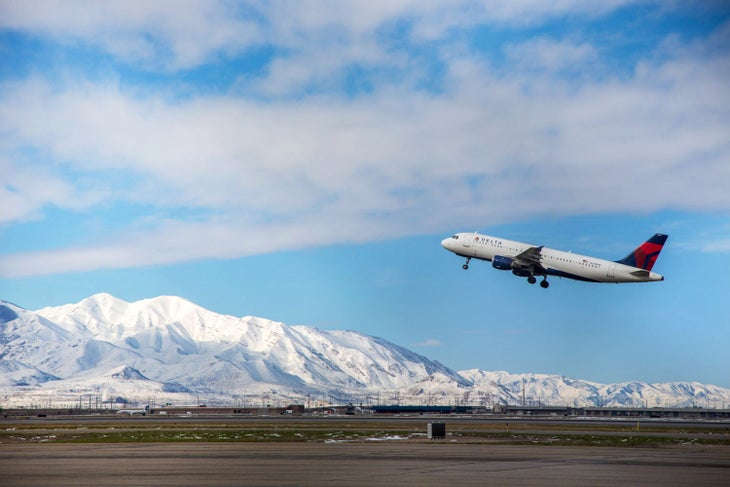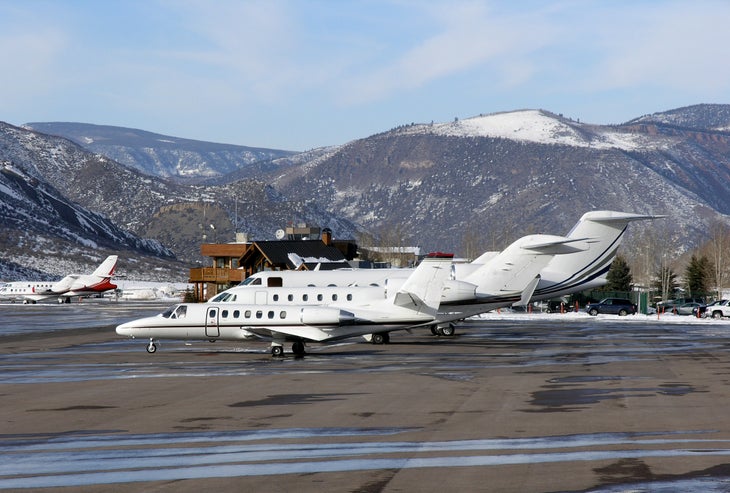Products You May Like
Get full access to Outside Learn, our online education hub featuring in-depth fitness, nutrition, and adventure courses and more than 2,000 instructional videos when you sign up for Outside+
Sign up for Outside+ today.
Check Out The Complete Multipass Buyer’s Guide
Not everyone can drop everything at the first sign of brewing clouds, but if you can, you’re doing something right. What you need is a pass that has 1) ski resorts within an hour from their respective airports, and 2) ski resorts with high average annual snow totals.
The third variable is the airport itself. If money is no object, you have lots of options in the form of small, regional airports that basically serve their respective ski areas: Aspen-Pitkin, Telluride Regional, Bozeman-Yellowstone, and more.
If value is important, however, a larger airport that serves a bigger region is the way to go. Lower fares and more flight options are all but guaranteed, and you can still find ski resorts within an hour from several major hubs.
Here’s a snapshot of which passes serve the most accessible ski resorts in U.S. for optimal storm-chasing and skiers looking for quick getaways next season.
Which Pass Has More Resorts Close to Major Airports?

How is it possible to know where it’ll snow? Great question. Ma Nature holds the cards on that one, but you can maximize your chances by having access to multiple resorts that are easy to get to. Here’s the breakdown on the passes offering resorts accessible from major airports.
Salt Lake City International Airport
This is the most convenient major airport in the country, within a 30-minute drive from nine ski areas. And six of them are on the Ikon Pass: Snowbird, Alta, Deer Valley, Snowbasin, Brighton, and Solitude.
The Epic Pass has one: Park City.
Best Pass for Powder Seekers
Ikon Pass can’t be touched when it comes to resorts accessed within an hour of SLC Airport. As for snowfall, Alta and Snowbird both average over 500 inches a season.
Reno-Tahoe International Airport
Reno-Tahoe airport is big enough to be efficient and small enough to be navigable. There are a dozen ski resorts within 60 miles, two of which belong to the Epic Pass (Northstar, and Heavenly) and one that’s on the Ikon Pass (Palisades Tahoe). Kirkwood, the 3rd Epic resort in the region, is another 30 miles south.
Best Pass for Powder Seekers
Epic Pass, because when Kirkwood (472 annual inches, the second highest in the region) goes off, it’s worth the extra miles.
Burlington International Airport
Burlington’s small but efficient airport is within an hour of Stowe, Sugarbush, Bolton Valley, and Mad River Glen, and about 90 minutes from the state’s snowiest ski area, Jay Peak. As far as powder hopes go, Jay is your best bet, logging just under 360 inches in an average winter.
Best Pass for Powder Seekers
Indy Pass, where your two days at Jay Peak are completely restriction-free, so you can choose any weekend to powder-seek in northern Vermont without worrying about blackout dates.
Denver International Airport
One of the country’s biggest airports also serves the Front Range ski resorts of the Rocky Mountains. While it’s true that most are a two-plus hour drive, there are two worthwhile options for pow seekers looking to score a cheap flight into DIA. Loveland Ski Area and Eldora Mountain are each about one hour and 20 minutes from the airport.
Best Pass for Powder Seekers
Powder Alliance’s two blackout-free days at Loveland, which gets 400 annual inches to Eldora’s 300, are enough for the perfect weekend trip.
Eagle County Regional Airport
While Denver International Airport is much bigger and will have far more flight options, savvy skiers know to check Eagle first when it comes to getting to Colorado’s Summit or Eagle County ski resorts. Yes, it’s a regional airport, but it’s bigger than most second-tier airports and serves several resorts, giving you more options to mine for pow.
The closest resorts to the Eagle airport are Vail Mountain and Beaver Creek, with Keystone and Breckenridge another half-hour beyond those. Ikon’s Copper Mountain is about an hour from Eagle. Arapahoe Basin, which gets the most snow of all of them, is an hour and 20 minutes.
Best Pass for Powder Seekers
Epic, with four resorts within 50 miles.
Which Pass Has More Resorts Close to Regional Airports

Of the regional airports that serve their respective ski resorts, the numbers don’t lie when it comes to which multipass has more skiing (see below), although you should count on paying more and having fewer flight options when you fly into these smaller airports. But for a quick weekend, their convenience can’t be beat.
Ikon Pass
- Mammoth-Yosemite Airport: Mammoth Mountain, 12 miles
- Yampa Valley Regional Airport: Steamboat, 28 miles
- Aspen-Pitkin Regional Airport: Aspen Snowmass, 4 miles (to Aspen Mountain)
- Jackson Hole Airport: Jackson Hole Mountain Resort, 21 miles
- Bozeman-Yellowstone International Airport: Big Sky, 52 miles (24 miles to Bridger Bowl)
- Friedman Memorial Airport: Sun Valley, 14 miles
Epic Pass
- Telluride Regional Airport: Telluride Ski Resort, 7 miles
- Gunnison-Crested Butte Regional Airport: Crested Butte, 31 miles
Power Pass
- Durango-La Plata County Airport: Purgatory, 42 miles
